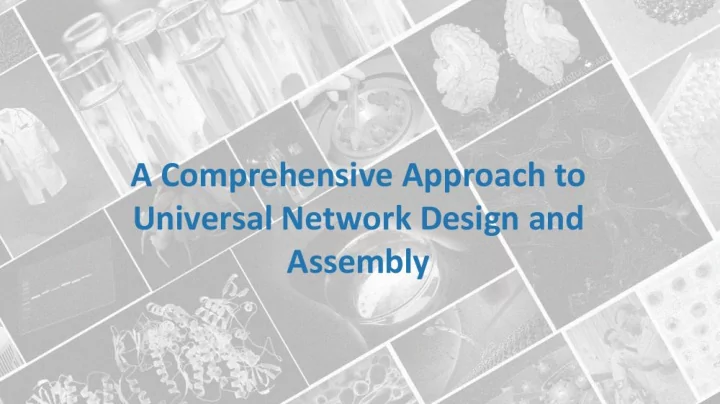

A Comprehensive Approach to Universal Network Design and Assembly
Introduction
DNA Assembly • This year, we improved upon our BrickMason assembly method from the 2011 season • 4-step: PCR, Digestion, Ligation, PCR Figure 1. 2011 uOttawa BrickMason assembly method. Gene dimers were created and connected via PCR.
DNA Assembly • Adapted the DNA assembler method from Shao et al.
DNA Assembly • Saves time by offering a two-step procedure for construction of large DNA pieces that is entirely PCR-based • Avoids the use of restriction enzymes and insertion of restriction sites between genes • Avoids the need for ligation • Not limited to dimers
Co-transformation • Combined Gietz & Schiestl LiAc/SS carrier DNA/PEG method with the DNA assembler method by Shao et al.
Co-transformation • Saves time by decreasing the amount of PCR cycles needed to stitch together DNA constructs • Reduces error that arises from multiple rounds of PCR • Saves money by using the LiAc/SS carrier DNA/PEG transformation method instead of electroporation • Allows two-fold screening for the desired final product – recombination success and proper integration can be screened for all at once via drug/color selection (ADE2/ADE4 cassettes)
Mating • Took advantage of S.cerevisiae ’s haploid and diploid states
Mating • Saves time by reducing the number of transformations needed to construct a complex gene network • Combinatorial nature of the procedure allows for simple construction of various gene combinations • Multiple testing platforms are created – the constructs can be tested in both the haploid and diploid state
Overall Workflow DNA Assembly Co-transformation Mating • • • One day Three days Two days • • • Two-step PCR Co-transformation Combinatorial amplification of of homologous mating of haploid genes of interest multimers strains
Goals of Characterization Project • Increase the predictability of genetic components • Test whether systems in haploids can be transferred to diploid systems • Effects of reporter tagging
Characterization of the Tet Repressor
Strain A Tagged Tet-Repressor Haploid BY4742 ( α ) Gal4::GEV Ade2::pGal-Tet-BFP Ade4::pGalTX-GFP
Strain B Tagged Tet-Repressor Diploid BY4741 (a) Ade2::pGal-Tet-BFP Ade4::GEV BY4742 (α) Ade2::URA3 Ade4::pGalTX-GFP
Strain C Un-Tagged Tet-Repressor Diploid BY4741 (a) Ade2::pGal-Tet-BFP Ade4::GEV BY4742 (α) Ade2::pGal-BFP Ade4::pGalTX-GFP
Results • All three strains have been built • Strains A and C are being confirmed • Strain B (Tagged-Tet, Diploid) has been tested
Figure 6. Background BFP and GFP Expression from Figure 7. Basal BFP and GFP expression from the Wildtype BY4743 Diploid Yeast Cells Tagged-Tet Diploid Testing Strain
Figure 8. Confirmation of the the Tet-Responsive promoter. Cells were induced with [200nmol ] β estradiol and [100ng/ul] aTc to prevent binding of the Tet repressor to the Tet-Responsive promoter
Characterization of the Tet-Repressor . Figure 9. Cells were induced with [200nmol] β estradiol to activate the gene network.
Characterization of the Tet Repressor in Diploid Yeast Cells Figure 10. Quantitative Flow Cytometry analysis.
Remarks • Characterization of the Tet repressor in Diploid yeast cells • Proof of concept of the Assembly Method • Continue with the testing of the other characterization strains
Promoter Design • Lack of inducible systems in yeast • Copper and Galactose inducible systems • Gal1 promoter is almost ideal for synthetic networks
Limitations of the Gal1 Promoter • Dependent on galactose which is also a source of energy for yeast • Galactose is not optimal for yeast growth
Gal1 Promoter Figure 11. Full Gal1 promoter sequence. Elena Frovola, Mark Johnston, and John Majors (1999). Binding of the glucose-dependent Mig1p repressor to the GAL1 and GAL4 promoters. Nucleic Acids Research Vol. 27, No.5
Gal1 Promoter Figure 12. Gal4 binding sites found in the Gal1 promoter. Elena Frovola, Mark Johnston, and John Majors (1999). Binding of the glucose-dependent Mig1p repressor to the GAL1 and GAL4 promoters. Nucleic Acids Research Vol. 27, No.5
Gal1 Promoter Gal4 Binding sites Foreign Operator sites a) Gal1 Promoter b) Desired Gal1 Promoter Figure 13. A visual representation of replacing the Gal4 binding sites with foreign operator sites.
Activation using VP16 VP16 DBD BFP Desired Gal1 Promoter Figure 14. A protein fused to the activation domain VP16 would theoretically be able to bind and activate the new Gal1 promoter.
Introduce Tet operator sites Gal4 Binding sites Tet Operator sites a) Gal1 Promoter b) New Gal1 Promoter Figure 15. A visual representation of replacing the Gal4 binding sites with Tet operator sites.
Assembly by Overlapping Nucleotides – Adapted from Gibson (2009) Figure 16. Re-circularization of a linear plasmid with multiple overlapping oligonucleotides with the ends homologous to the plasmid.
Assembly by overlapping nucleotides • Linearize pRS vector • Co-transform plasmid and oligonucleotides into yeast • Extract plasmid DNA from yeast • Transform plasmid DNA into E. coli • Extract plasmid DNA • Sequence or PCR confirm
Sequencing results • 9 Plasmids sequenced • 33% success rate Figure 17. Sequence of 1 out of 9 E. coli plasmids that were sequenced. The red highlighted nucleotides correspond to the Tet operator sites.
Future Directions • Replacing Gal4 sites with LexA and LacI operator sequences • Induction of the new Gal1 promoter with TetR-VP16 • Observe and quantify any change in expression of the new Gal1 promoter
Human Practices • Full length documentary produced with the aid of multiple professors and researchers in the University of Ottawa. • Highlights the issues and hurdles synthetic biology is expected to overcome in order to mature as a field, along with regulatory suggestions. • Watch it!
Conclusion • Utilizing unique characteristics of yeast, we improved previous assembly methods • Diploid strain was tested as a characterization platform • Modified Gal1 promoter • Created the Nature of Synthetic Biology documentary
Thank You
Recommend
More recommend